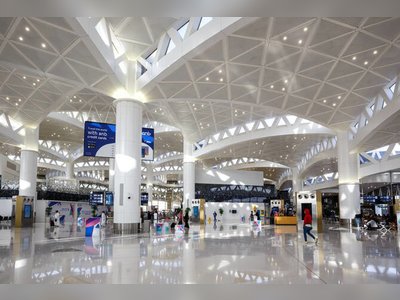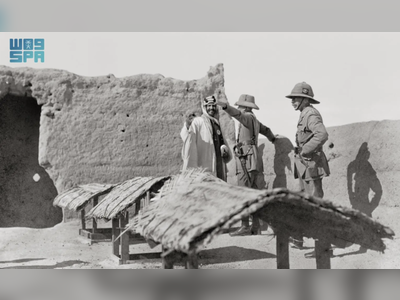Port blast, Covid delivers tourism 'catastrophe' to Lebanon
Estimated losses top $1bn as 2,060 restaurants and 163 hotels out of 250 hotels in Greater Beirut were severely damaged by the blast
The most affected hotel is the Phoenicia, whose rehabilitation cost is estimated at $15 million, followed by the Four Seasons, Hilton, Monroe and Le Gray Hotels (pictured), said Ashkar.
Around this time of the year, Lebanese hotels used to bid farewell to their many Gulf guests returning home before the start of the new school term in early September, after spending a summer holiday in Lebanon.
Today, many hotels are without guests.
Hotel managers can only dream about 2010, when Lebanon beat all previous tourist-arrival records with more than two million visitors.
The figures alone are enough to illustrate the disaster that struck the Lebanon’s tourism and hotel sector after the Beirut port explosion on August 4 - 2,060 restaurants and 163 hotels out of 250 hotels in Greater Beirut were severely damaged by the blast, with losses exceeding $1 billion, according to the final assessment by the Syndicate of Hotels Owners in Lebanon.
"It's a catastrophe for Lebanon, the explosion damaged 90 percent of Beirut’s hotels," Pierre Ashkar, president of the Syndicate told Arabian Business.
Ashkar revealed that the World Bank is discussing the possibility of setting up a support fund that could help the sector out of its crisis.
Tourism accounted for nearly a fifth of Lebanon's GDP in 2018, when two million people visited the country. The sector has suffered another huge blow. More than half of the employees in the tourism sector have lost their jobs as a result of the damage caused by the port explosions.
The cost of repairing hotels ranges from $200,000 to $15 million per property, while it is difficult to assess the indirect losses caused by the complete or partial closure of hotels, according to Ashkar.
The most affected hotel is the Phoenicia, whose rehabilitation cost is estimated at $15 million, followed by the Four Seasons, Hilton, Monroe and Le Gray Hotels, said Ashkar.
The downturn in the tourism and hotel sector began in 2011, after the outbreak of war in Syria, when the country witnessed a strong division over intervention in the Syrian war and the subsequent halt in the flow of tourists from the Gulf to Lebanon, estimated at about 350,000 tourists per year.
Ashqar added: "The Arab Gulf is the largest employer of the Lebanese, with an estimated number of about 450,000 people, who transfer billions of dollars annually to Lebanon, and the Gulf countries are the largest investors in Lebanon, in addition to the fact that the Gulf tourist is the mainstay of tourism in Lebanon, as he spends three times what an American or European tourist spends.
"The length of his stay varies between 10 and 15 days, while American or European tourists travel from three to five days.
"After the Syrian war and the tension it generated... tourism started to decline every year, so that revenues fell by 40 percent compared to the period before 2011, when tourism revenues in Lebanon amounted to $9 billion per year.
The partial recovery in 2018 was short-lived, as the economic and financial crisis came. Then the corona epidemic, and the sector suffered a setback again, as revenues dropped dramatically and occupancy rates fell to unprecedented levels, reaching 13 percent in Beirut and 5 percent in Lebanon in 2020,” Ashkar told Arabian Business.
The average occupancy rate at four- and five-star hotels in Beirut was 13 percent in the first half of 2020 compared to 70 percent in the same period of 2019, and compared to an average rate of 40.5 percent in 14 Arab markets according to EY's benchmark survey of the hotel sector in the Middle East.
The occupancy rate at Beirut hotels was the lowest in the region in the covered period, while it was the sixth highest in the first half of 2019. The occupancy rate at hotels in Beirut regressed by 57 percentage points in the first half of 2020, constituting the steepest decline in the region.
In comparison, the average occupancy rate in Arab markets declined by 25.6 percentage points in the covered period.
The occupancy rate at Beirut hotels stood at just 3 percent in June, down 74.2 percent compared to the year-earlier period.
Betting on foreign aid, Ashkar said: "The Beirut Port explosion has put an end to any hope of recovery soon, as the destruction has been massive and 163 hotels have been damaged, ranging from severe to mild.
With the severe economic crisis combined with the measures accompanying the spread of the corona epidemic, it is difficult to find a vision for the future of Lebanon’s tourism and hospitality sector.
Therefore, all we have to do is seek the support of international bodies, considering that the Lebanese state is bankrupt, and the World Bank has contacted us with the aim of assessing the damage in hotels and discussing the possibility of setting up a support fund that could help the sector out of its crisis.”
The average rate per room at Beirut hotels was $130 in the first half of 2020, down by 34.5 percent from $199 in the same period of 2019 while revenue per available room (RevPAR) was $16, the lowest rate in the region, and down from $138 in the same period of 2019.
Around this time of the year, Lebanese hotels used to bid farewell to their many Gulf guests returning home before the start of the new school term in early September, after spending a summer holiday in Lebanon.
Today, many hotels are without guests.
Hotel managers can only dream about 2010, when Lebanon beat all previous tourist-arrival records with more than two million visitors.
The figures alone are enough to illustrate the disaster that struck the Lebanon’s tourism and hotel sector after the Beirut port explosion on August 4 - 2,060 restaurants and 163 hotels out of 250 hotels in Greater Beirut were severely damaged by the blast, with losses exceeding $1 billion, according to the final assessment by the Syndicate of Hotels Owners in Lebanon.
"It's a catastrophe for Lebanon, the explosion damaged 90 percent of Beirut’s hotels," Pierre Ashkar, president of the Syndicate told Arabian Business.
Ashkar revealed that the World Bank is discussing the possibility of setting up a support fund that could help the sector out of its crisis.
Tourism accounted for nearly a fifth of Lebanon's GDP in 2018, when two million people visited the country. The sector has suffered another huge blow. More than half of the employees in the tourism sector have lost their jobs as a result of the damage caused by the port explosions.
The cost of repairing hotels ranges from $200,000 to $15 million per property, while it is difficult to assess the indirect losses caused by the complete or partial closure of hotels, according to Ashkar.
The most affected hotel is the Phoenicia, whose rehabilitation cost is estimated at $15 million, followed by the Four Seasons, Hilton, Monroe and Le Gray Hotels, said Ashkar.
The downturn in the tourism and hotel sector began in 2011, after the outbreak of war in Syria, when the country witnessed a strong division over intervention in the Syrian war and the subsequent halt in the flow of tourists from the Gulf to Lebanon, estimated at about 350,000 tourists per year.
Ashqar added: "The Arab Gulf is the largest employer of the Lebanese, with an estimated number of about 450,000 people, who transfer billions of dollars annually to Lebanon, and the Gulf countries are the largest investors in Lebanon, in addition to the fact that the Gulf tourist is the mainstay of tourism in Lebanon, as he spends three times what an American or European tourist spends.
"The length of his stay varies between 10 and 15 days, while American or European tourists travel from three to five days.
"After the Syrian war and the tension it generated... tourism started to decline every year, so that revenues fell by 40 percent compared to the period before 2011, when tourism revenues in Lebanon amounted to $9 billion per year.
The partial recovery in 2018 was short-lived, as the economic and financial crisis came. Then the corona epidemic, and the sector suffered a setback again, as revenues dropped dramatically and occupancy rates fell to unprecedented levels, reaching 13 percent in Beirut and 5 percent in Lebanon in 2020,” Ashkar told Arabian Business.
The average occupancy rate at four- and five-star hotels in Beirut was 13 percent in the first half of 2020 compared to 70 percent in the same period of 2019, and compared to an average rate of 40.5 percent in 14 Arab markets according to EY's benchmark survey of the hotel sector in the Middle East.
The occupancy rate at Beirut hotels was the lowest in the region in the covered period, while it was the sixth highest in the first half of 2019. The occupancy rate at hotels in Beirut regressed by 57 percentage points in the first half of 2020, constituting the steepest decline in the region.
In comparison, the average occupancy rate in Arab markets declined by 25.6 percentage points in the covered period.
The occupancy rate at Beirut hotels stood at just 3 percent in June, down 74.2 percent compared to the year-earlier period.
Betting on foreign aid, Ashkar said: "The Beirut Port explosion has put an end to any hope of recovery soon, as the destruction has been massive and 163 hotels have been damaged, ranging from severe to mild.
With the severe economic crisis combined with the measures accompanying the spread of the corona epidemic, it is difficult to find a vision for the future of Lebanon’s tourism and hospitality sector.
Therefore, all we have to do is seek the support of international bodies, considering that the Lebanese state is bankrupt, and the World Bank has contacted us with the aim of assessing the damage in hotels and discussing the possibility of setting up a support fund that could help the sector out of its crisis.”
The average rate per room at Beirut hotels was $130 in the first half of 2020, down by 34.5 percent from $199 in the same period of 2019 while revenue per available room (RevPAR) was $16, the lowest rate in the region, and down from $138 in the same period of 2019.













